
Before you read this report: The Costa Rican government announced on March 23, 2021, after the Spanish version of this report was produced and published, that it will open land borders for tourism on Monday, April 5, 2021.
Every year, the day when Easter is celebrated falls on a different date. Holy Week might be in March, it might be in April, or like this year, it might fall between the two months. Regardless of the dates, Peñas Blancas, on the border between Nicaragua and Costa Rica, was as busy as an anthill with people coming and going.
Hundreds of Costa Rican and foreign tourists decided to cross to Nicaragua to take a dip in the waters of San Juan del Sur, a hop, skip and a jump from the border. For thousands of Nicaraguans and Ticos, in one territory or the other, these days off meant reuniting on the other side with their family and friends. Everyone huddled in endless lines waiting for their passports to get stamped.
The anthill was topped off by those who were there all the time: Nicaraguan vendors determined to convince each traveler to buy at least one bag of snacks from them, currency exchangers with their rolls of dollars, cordobas and colones ready to do mental math and give tourists the currency they needed for their journey. Cart drivers, taxi drivers, vendors selling snacks, people working at little snack bars or convenience stores…
Holy Week was like a sweet giant candy for the anthill at Peñas Blancas and, incidentally, for the economy of the nearby municipalities: La Cruz on the Costa Rican side, and Cardenas and San Juan del Sur in Nicaragua.
That anthill was stomped on by a pandemic. Everyone in both countries, on each side of the border, was knocked down.
Costa Rica, which took drastic measures to handle the health crisis, has relaxed its restrictions little by little to get to a new normal, including completely reopening its air and maritime borders to all countries.
Although Nicaragua didn’t close the border, it required a negative test for the coronavirus for those who enter the country, even for its citizens. The impositions of both countries informally moved the border a few kilometers away from Peñas Blancas, where Nicaraguans and Ticos cross and circumvent the governments’ rules.
The anthill of Peñas Blancas is still as devastated and deserted as it was on day one. Costa Rica hasn’t opened land borders for those who aren’t residents or citizens. The borders remain closed and people who live on both sides have now gone hungry for more than 365 days.
The Voice of Guanacaste, Interferencia de Radios UCR and Confidencial from Nicaragua worked together on this binational report to understand how the Costa Rican government’s decision to extend again the closure of land borders over and over and Nicaragua’s strict requirement are impacting the economy of those who made a living from Peñas Blancas.
Hunger Doesn’t Understand Reasons
Pedro Antonio Vargas can’t stop saying again and again that since the beginning of the pandemic he, his brother and his two children are “surviving.”
They eat beans with a side of guineo banana and a little bit of cheese. They collect the few eggs that their chickens sometimes lay. And with that, they “fool the [children],” his brother, Jose Jesus Romero, said.
The two of them, Nicaraguans with Costa Rica residency, have been working as cart drivers for 35 years, carrying travelers’ suitcases in one direction or another or taking the goods from trucks to the fiscal warehouses.
Before the pandemic, their daily income was between 4,000 and 10,000 colones (about $6.65 to $17) — on a good day. Now their pockets are practically empty. “Sometimes I don’t even have a thousand colones,” (about $1.65) said Pedro.
If the only concern was food, he said it wouldn’t be such a problem. He’s used to walking around with an empty stomach now. But his children are his greatest concern.
They go to [high] school and sometimes in the morning, they go without breakfast. I lie down and my head hurts from thinking… I could have a stroke,” he related in anguish.
Being a cart driver is an informal job, like the majority of a countless number of people who lived off the hustle and bustle of the Peñas Blancas border post, which, in part, is the result of limited job options in the area.
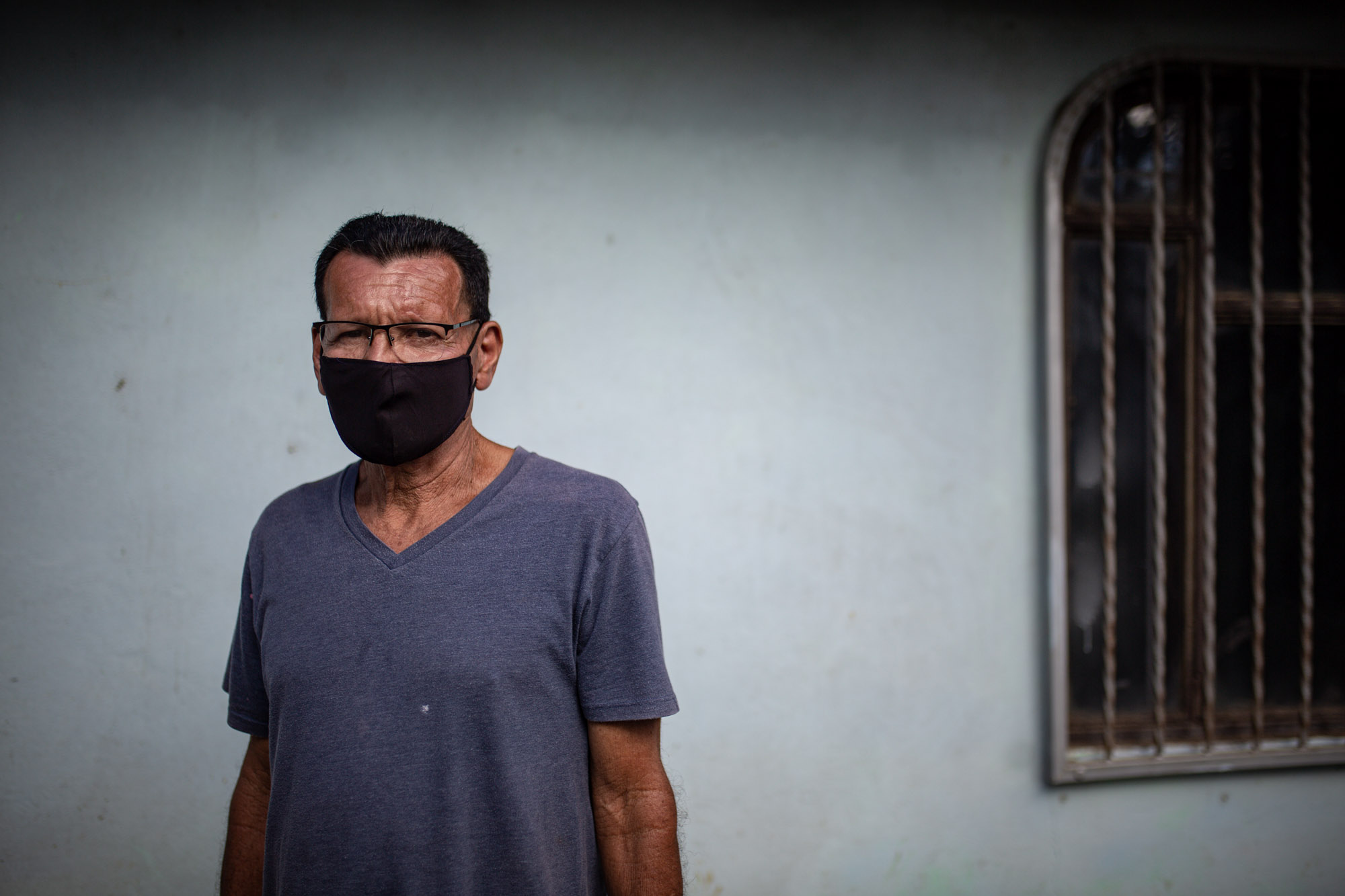
Pedro Vargas used to earn a living carrying suitcases and merchandise on the Costa Rican side of Peñas Blancas. Now, every day, he wakes up thinking about how he will eat during the day, any little job he can get paid for. Photo: Cesar Arroyo Castro.
For anyone, making a living from day to day earnings at Peñas Blancas was attractive, even without the guarantees offered by formal work. During 2019, for example, an average of 3,327 people crossed each day. After March 2020, however, the number doesn’t even reach 700.
It’s an economic magnet in poor towns. La Cruz, for example, the canton closest to Nicaragua in the province of Guanacaste, has an economy based mainly on agriculture and livestock and the employment generated by a large hotel on the coast. In Nicaragua, Cardenas is a small town that depends on income from the border, tourism and livestock.
The brothers, Pedro and Jose Jesus, estimate that around 75 people did the same kind of work as them on the Costa Rican side of the border. Add to that the currency exchangers.
One of their acquaintances, Jesus Chaves, who did the same kind of work, said there are 60 members just in the association that he belongs to. A few others worked without being associated with any union.
They also did business— exchanging colones, cordobas and dollars— with their Nicaraguan colleagues, who number around 73, according to calculations by the president of the Gaspar Garcia Laviana union, named Francisco Urbina.
Together, on both sides of the border, there are hundreds of them, an uncounted figure that isn’t officially registered. Regardless of the number, they went from having enough to live each day to having empty pockets, even during what used to be the high seasons.
This December was normal. Normal. Just like Easter week [2020]. There was no influx of tourists. People didn’t come down. Nobody came down. Nobody. Nobody,” repeated Jose Serrano, another currency exchanger in Nicaragua.
“Well, everything was like that, normal, as if there was no special occasion, like nothing happened.”
“Like nothing happened,” he said. In reality, although commercial transportation is authorized, and the cart drivers could carry that merchandise and the currency exchangers could work with the few who cross the border, on both sides they are prohibited from entering the primary zone, in other words, the areas around the immigration offices.
“My husband tells me ‘No, no, no. Don’t worry,’” related Maria Cristina Perez, a Nicaraguan baker who used to sell her rosquillas in Peñas Blancas before the pandemic. “We always eat, yes. With faith in God, we all always eat.”
Others, like Costa Rican currency exchanger Jesus Chaves, live regretting every second that they took precautions due to the virus, due to death.
“I made the biggest mistake by being obedient to all the regulations that the Ministry of Health asked of us, “stay at home,” “don’t go out” and that… Why?” he asks himself as if wanting to turn back time with a new plan to change his life and that of the three children he’s raising, “because if I had continued working, even with the truck drivers, maybe I would have found resources to survive and not spend what I had.”
Even though he regrets it, he is grateful that his savings have helped him for months to not fall off the cliff. But savings wasn’t the norm for his colleagues, he said. “Our companions have called me and said, ‘Jesus, don’t you have something there? I don’t have anything to cook for my children.’”
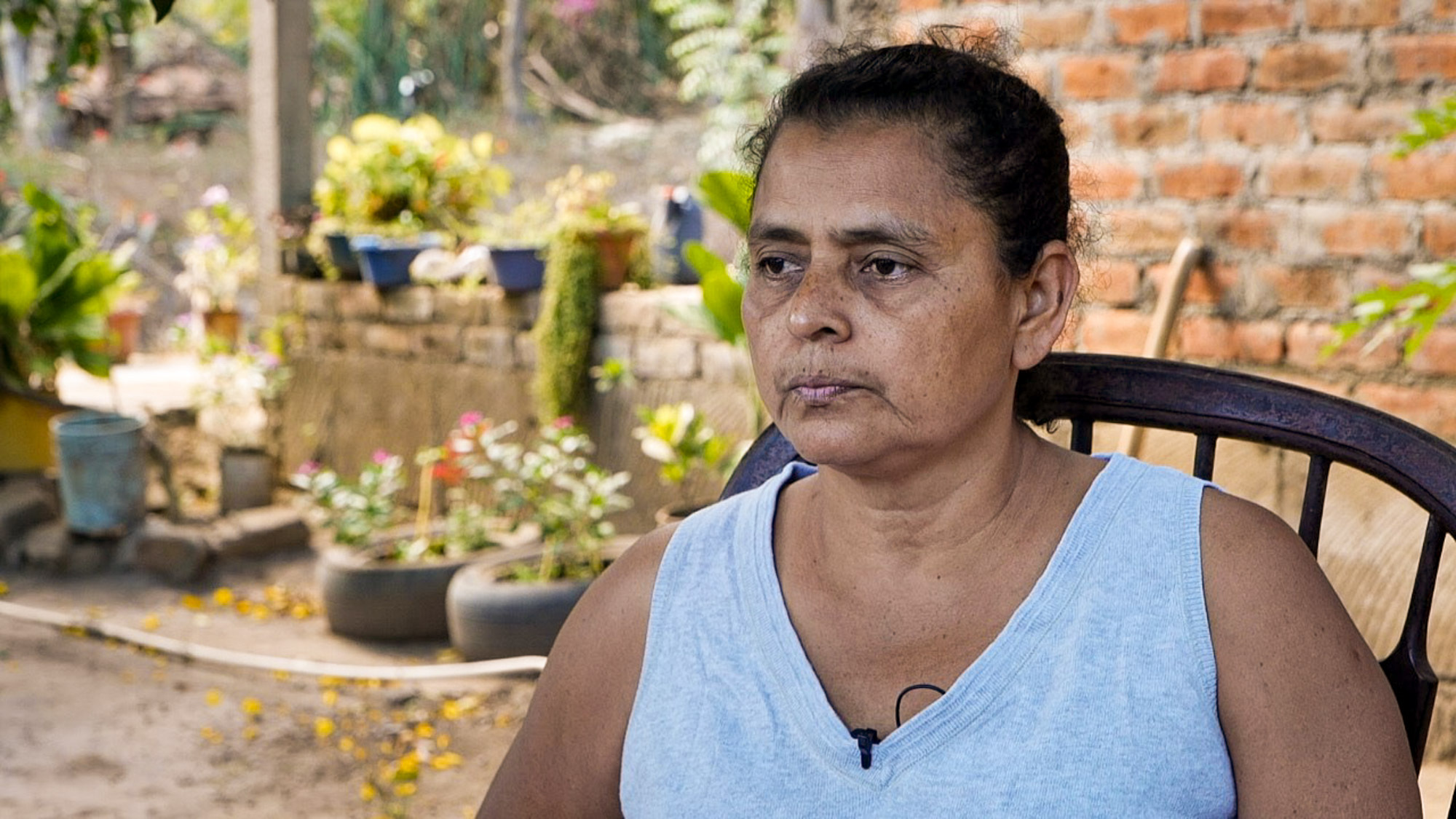
Maria Cristina Perez sells rosquillas in Peñas Blancas, Nicaragua. She used to earn up to 1,000 cordobas (about $29) a day before the pandemic. In high season, like January or Easter week, she sold more. Now, nothing, she says. Photo: Confidencial.
Although brothers Pedro and Jose Jesus have felt the noose around their necks, they want to believe that the government is doing this for their good. “[The coronavirus] is a terrible, latent danger. Well, I had Covid, and then I said, ‘The Health workers know what they’re doing. The authorities know what they’re doing.’”
The extended land border closure decrees by the Costa Rican government have been as repetitive as the questions that the press ask authorities looking for clarification about the decision. The task hasn’t been easy. The answers are technical and brief.
“A review is made of infection rates in relation to population sizes, infection rate trends compared to previous periods and general results of public health measures applied in the countries.”
“The technical team constantly evaluates the requirements that were established for land borders, taking into account the risks and the number of Costa Ricans who transit through said border.”
These are among the responses from the Ministry of Health press department to prior inquiries from the media that are working together on this report. By the time this article was published, the Ministry of Health hadn’t granted an interview with Minister Daniel Salas. The interview was requested in order to understand the answers given to the press and the health reasons for the closure of the borders.
The minister’s last public explanation took place during a press conference on February 22 this year:
“You also have to know the reality of everything that is happening when entering by land. They don’t just come from neighboring countries but they even come from other countries on very long trips, often even in very precarious health conditions, and that also increases the risk of transmission.”
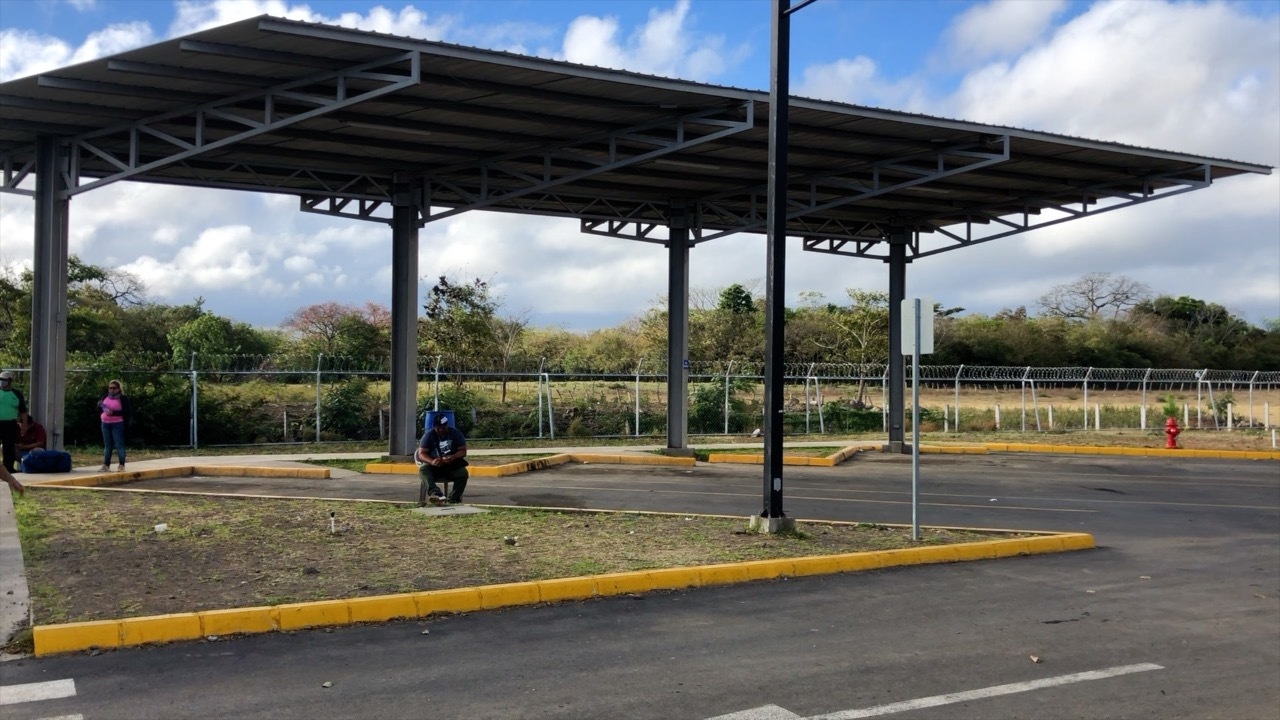
On the Nicaraguan side, Peñas Blancas also looks abandoned. Only a few informal workers wait for the few travelers who pass through there. Photo: Confidencial.
Of course, Costa Rica allows visitors to enter by air from any country without the need for a COVID-19 diagnostic test or quarantine, just travel insurance. Even Nicaraguans or Panamanians can enter Costa Rica if they can afford the flight.
Looking for Something Else to Do
Many have left behind the job that fed them for years. But shifting to other sources of employment isn’t easy. Pedro and Jose Jesus do whatever work they can: fixing things like televisions, running errands for neighbors, doing yard work. Whatever.
“There are times you can’t sleep thinking about things. What are you going to do tomorrow. What you are going to do about this, about that… You wake up thinking that you’re going to work, and you’re not going to work,” said Pedro, meaning that there is no work, that because of their ages, 68 and 57, they’re less likely to be given jobs.
I suffer for my boys. My boys, when I worked, ate their little things, their Corn Flakes.” Cereal has become a luxury like never before.
Informal jobs weren’t the only ones that were lost. Jose Chaves has a convenience store in Peñas Blancas, on the Nicaraguan side, and, due to the pandemic, he had to lay off three employees. He estimates that his sales are down nearly 80 percent.
“I had many customers from the Costa Rican side who came through the fields to buy a lot of groceries, mostly chicken and beef, because it costs less than there,” he said, and explained that these are people who mainly sell food to truck drivers on the Costa Rican side.
The same has happened with customs businesses and international travel companies.
That’s why the owner of Transnica, Oscar Alfaro, describes the economic impact for those who lived off of travelers crossing the border as “apocalyptic.” They have suspended contracts, cut hours, lowered wages, laid off workers.
It’s very painful to send people home without a salary, knowing the needs that we have as human beings, as families,” he admitted.
Before the pandemic, the bus company transported 10,000 people a month, but today they take maybe 400, according to his own estimates. That’s why they didn’t have any other option but to lay off people like Andreina Ledezma, a Costa Rican who for 18 years, sold tickets back to the border to those who entered Costa Rica.
“That day, I remember, I went to work like normal and our immediate boss came and told me that they were going to close the border for a month, that we should go home and that they would be calling us. And that month turned into two months, three months and now almost a year,” she related.
At first, her family helped her pay for electricity, water, telephone, food. “Thank God I don’t pay rent. It’s like an advantage,” she said.
But relying on her family like that became unfeasible as the days passed. So she decided to drive a pirate taxi, until she crashed the car less than a month ago and broke her ankle. Now she’s resting at her mother’s house.
Lost Taxes
The border not only fed the families of those who worked there, but it also fed the municipal coffers of the border cities. Now, however, like the pocketbooks of those homes, the coffers are in a slump.
At noon, the bustle doesn’t stop at the Municipality of La Cruz. At the entrance, a greeter points out and makes sure health protocols are followed: washing hands, putting on hand sanitizer, checking temperatures. “Thank you for coming to talk about this issue,” the vice mayor, Ada Luz Osegueda, repeats over and over again.
Osegueda took office at the municipality along with Mayor Luis Alonso Alan on May 1, 2020. That same day, the first case of COVID-19 was announced in the canton and by then, the border had already been closed for a month and a half. “It’s frustrating. Peñas Blancas is an economic engine,” explained Alan.
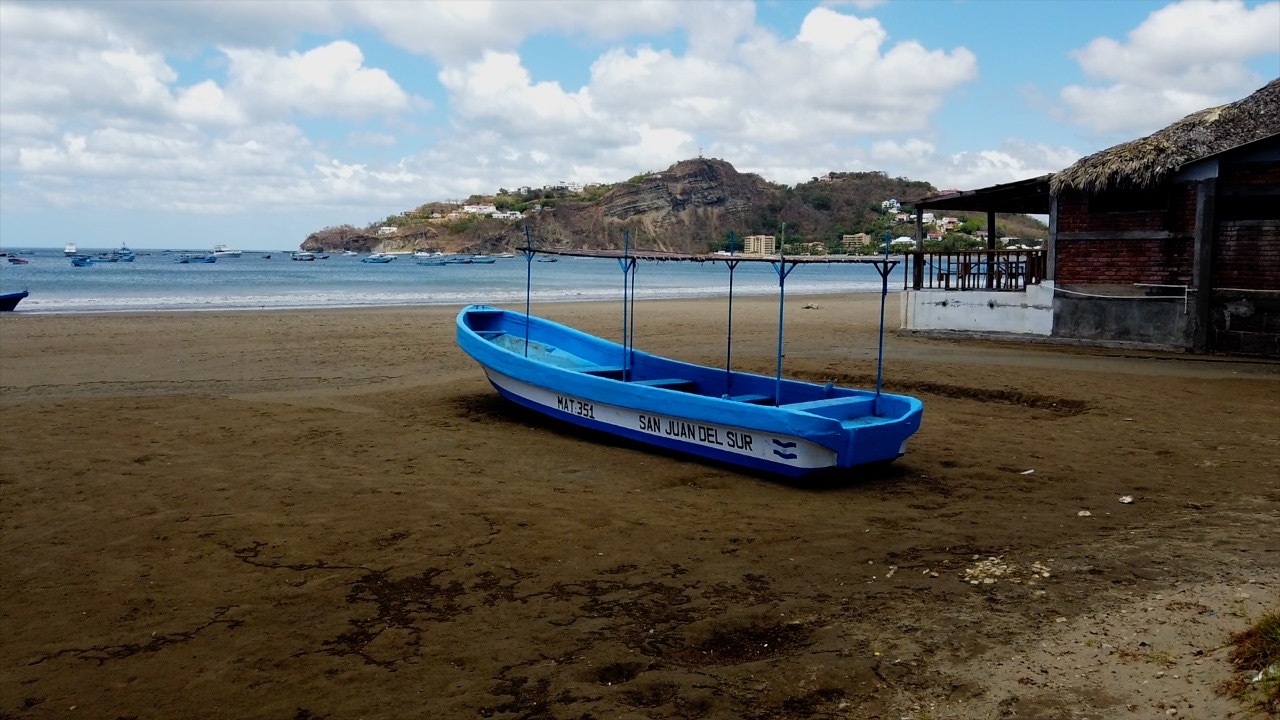
The tourist city of San Juan del Sur, located less than an hour from the border post, has lost a big part of its tourist flow. Tourists arriving from Costa Rica by land are now very scarce. Photo: Confidencial.
The mayor estimates that in 2020, about 300 people who had formal and informal jobs were affected just in this area.
But in addition, travelers have to pay a $5 departure tax. Since 2016, half of that tax has been received by the local government of La Cruz, which constituted almost a third of the canton’s general budget, according to the mayor. They also receive other customs taxes for cargo transportation across the border, which have remained steady, with the exception of the last week of May 2020.
With the border almost deserted, the municipality received half of what it usually received. In 2019, that income was 1.313 billion colones (2.1 million dollars). In 2020, they collected 653 million colones (just over a million dollars).
That money has been so important that it helped to pay off the debt and the deficit that the municipality had accumulated by 2015. Now that the amount of this tax collected has dropped, the municipality will have problems financing public works and projects for the community.
The story is the same less than 40 kilometers (less than 25 miles) away, on the other side of the imaginary border line, in Cardenas, Nicaragua. Council member Lesbia Vilchez explained that, when entering the country through Peñas Blancas, foreigners have to pay a $1 tax that goes to the mayor’s office in that municipality.
If they collected, let’s say $1,000 a day when there was a flow of tourists, now they don’t even collect $200. I can tell you not even $100,” said Vilchez, worried.
It’s not for nothing. This tax has constituted almost half of the municipality’s own funds. With this money, social expenses were covered, such as the partial maintenance of a preschool, a maternity ward and a high school distance learning program. Last year, they struggled to pay council members’ allowances and even staff salaries.
The municipality has had to come up with ways to reduce losses and create new taxes in real estate, street vendors, even starting to collect a tax on motorcyclists who transport Nicaraguans who enter their country from Costa Rica illegally through the “blind spots.” Once in Nicaraguan territory, they are offered transportation services, Vilchez specified.
With these maneuvers, the mayor’s office projects a budget of 9 million cordobas (2.5 million dollars) for 2021.
A Reunion with No Set Date
Cristhian Garcia misses her family’s warmth. With the pandemic and the border closing, she hasn’t been able to see them. She is alone in Costa Rica.
The young woman is one of tens of thousands of Nicaraguans who came to Costa Rica seeking refuge after the outbreak of the socio-political crisis in Nicaragua in 2018, when the country decided to provide medical assistance to those injured by state repression.
She can’t return to her country for fear of reprisals from the Government and its fanatics, and the process of requesting refugee status doesn’t allow it. The only way for her to see her loved ones again is for them to visit her in Costa Rica.
“My plans were to bring my family last year during Easter week, but the pandemic and the border closure prevented me from doing so. I thought that by this time, things would improve and I could bring them to visit, but time passes and the border remains closed,” she related sorrowfully.
It’s hard to afford a plane ticket for one person. It’s very expensive, even though we’re just a jump from Nicaragua.” A round-trip ticket between Nicaragua and Costa Rica is around $500.
The Border that “Moved”
They know about it on the Nicaraguan side and on the Costa Rican side too. The closed border didn’t interrupt the flow of people between one country and the other, it just caused the crossing to move from Peñas Blancas to the “blind spots.” In other words, it promoted illegal crossing. Townspeople and local authorities say so.
“Now you see that the border is no longer Peñas Blancas. It’s other places. People keep coming, keep going, just like always. Right now with Easter week coming, it’s a lie that they’re going to stop here. No way!” commented Andreina, the young return trip ticket seller from La Cruz.
“By December, the border practically moved to Cardenas, because they’re coming through Los Angeles, through Colon, here behind the wall…,” confirmed the council member from Cardenas.
“A decision like closing the borders for so long has caused us to have constant uncontrollable crossing points in Conventillos, in the surrounding areas of Peñas Blancas, in La Libertad, in Santa Elena, in Santa Cecilia, in the maritime part. What has been promoted is illegal immigration in a canton that has almost 70 kilometers (43 miles) of land border,” explained the mayor of La Cruz.
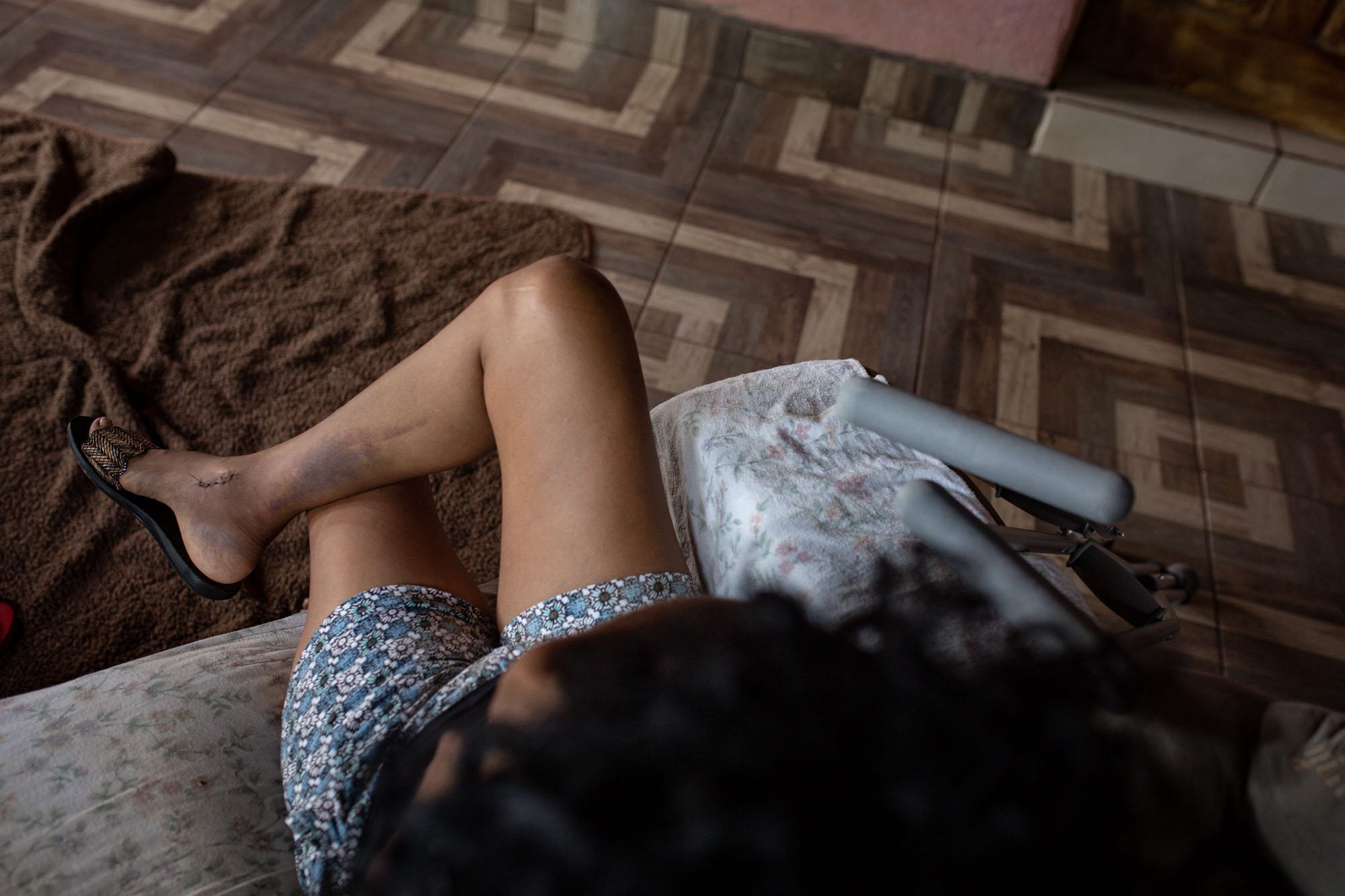
Andreina Ledezma spends her days resting her fractured ankle, which was operated on. She started to drive a taxi in La Cruz to support her two children and pay her household bills, until she lost control of her vehicle one night in February and hit a tree. Photo: Cesar Arroyo Castro
Alan thinks the Safe Borders operation didn’t have the expected result. Since March 19, 2020, the Costa Rican Ministry of Public Security has deployed all of the country’s different police forces to monitor the country’s land borders— an integration of forces that authorities classified as historic. “Nobody passes through here!” declared Vice President Epsy Campbell at the time, referring to the border with Nicaragua.
The mayor’s perception is that the economic crisis caused by the pandemic forced Nicaraguans who lived in Costa Rica and who had lost their jobs to return to their country, where the cost of living is lower and where, even unemployed, they manage to come up with ways for their families to eat every day.
The thinking in the operation was that, due to the health issue, due to what was going to happen in the sister country of Nicaragua, we were going to have a very strong immigration of people who wanted to seek health systems to get treatment and flee from the pandemic.”
He said that because in Nicaragua, a state of emergency wasn’t declared. There were no border closures or restrictions. Rather, the government there promoted mass gatherings and the normalization of social activities, so the number of coronavirus infections was higher than in Costa Rica, although the official figures in Nicaragua insist on hiding the true impact of the pandemic.
For him, the operation’s failure occurred when the Nicaraguans who initially went back to their country returned to Costa Rica through blind spots during the months when police presence had already decreased, mainly in December.
That fits with what Johanna Rodriguez, Costa Rica’s regional police chief for Immigration and Foreign Affairs, explained. In November, when the airports were opened, immigration officers stationed at the land borders had to return to their duties. She added that the Safe Borders operation continues in force and will be reinforced from March 25 to April 11 due to Holy Week.
More Monitoring, More Denials
According to data from the Office of Immigration and Foreign Affairs of Costa Rica, from March 19, 2020 to March 10, 2021, the police forces denied entry to 26,319 people at the border between Costa Rica and Nicaragua, the vast majority of Nicaraguan nationality. The data takes into account those who tried to enter illegally and those who didn’t meet immigration requirements.
Denials doubled between 2019 and 2020, but there was also a 70% increase between 2018 and 2019, before the pandemic.
Rodriguez indicated that the increase in denials doesn’t imply an increase in immigration flow. “Since the border is closed, we have a few more resources to be able to monitor all those parts [with blind spots] and a few more [immigrants] have been captured… but this behavior isn’t the product of last year or of this year. Rather, it’s from quite a few years.”
“Our borders are extremely porous and we don’t have [enough resources] to have the number of officers that people might want. It’s not something very feasible due to the amount of resources, the logistics, the fatigue, the economic expense,” added Rodriguez.
We requested information from the Costa Rican Ministry of Public Safety about the results of the Safe Borders operation, but as of the publication of this report, there was no response.
Mayor Alan also warned that the border closure strengthens gangs that engage in illicit activities, like charging for smuggling immigrants across blind spots.
Right now all of the results of what is being done are negative, or most of it. The government has to listen more to local authorities, to people who live in the canton,” Alan expressed.
There is another “incentive” for illegal immigration, in addition to the closed border, the official added, and that’s the entry requirement that Nicaragua asks of foreigners and citizens: a negative COVID-19 test result, which costs around $100.
It’s a price that many immigrants can’t pay, like the 500 Nicaraguans who were stranded for almost two weeks in Peñas Blancas last year in July.
It also happens in the opposite direction, with Nicaraguans crossing from Nicaragua to Costa Rica. “We asked them why [they cross illegally], if they have the ability to enter the country as residents, and many times they indicate that it’s because it’s better there or cheaper,” affirmed the regional Costa Rican immigration police chief.
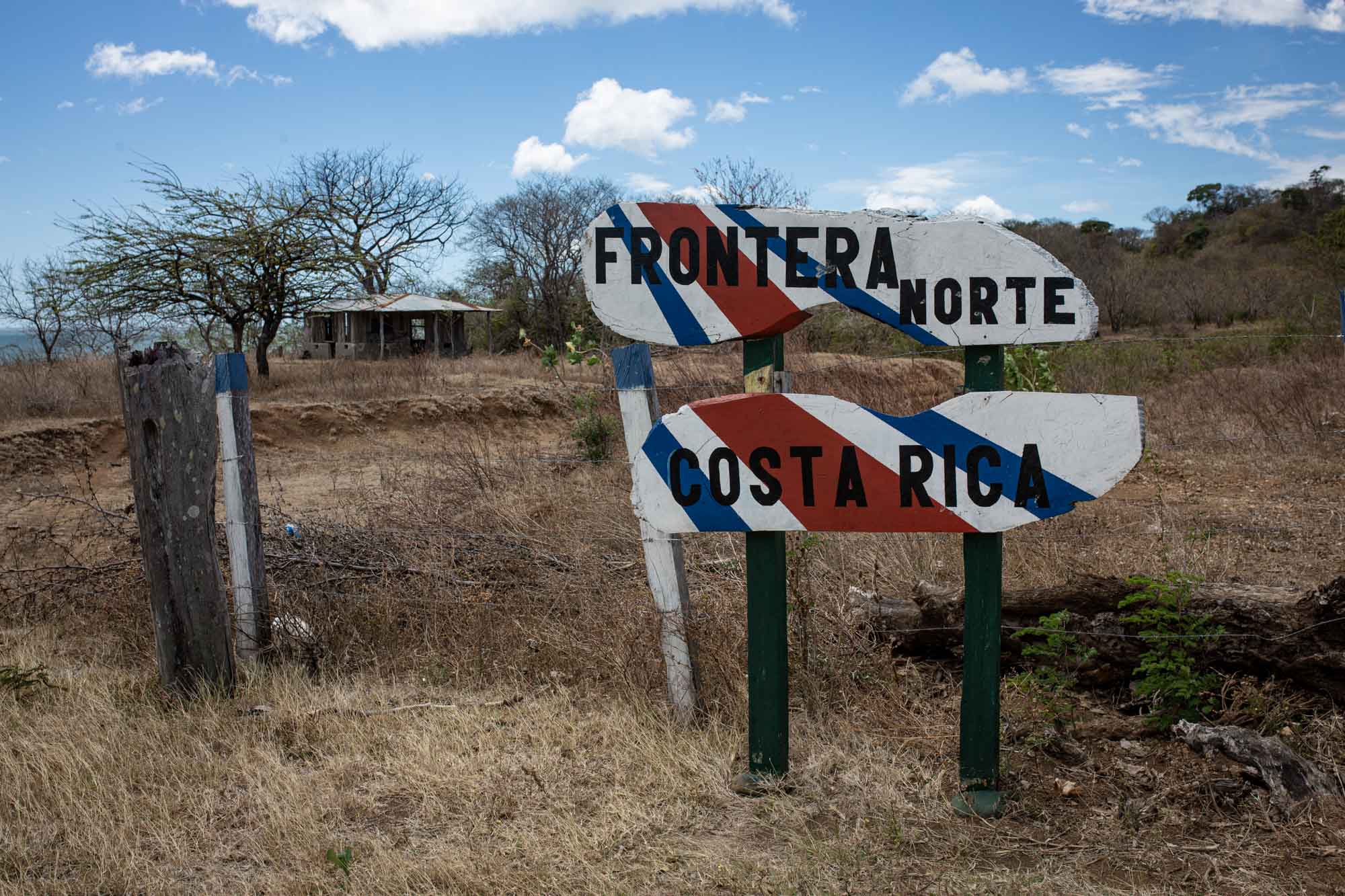
To local authorities and people who live near Peñas Blancas, closing the official border post only promoted illegal crossing along the 300 kilometers (185 miles) of shared border between Costa Rica and Nicaragua. The Conventillos area, between La Cruz and San Juan del Sur, is one of those points. Photo: Cesar Arroyo Castro.
Uncertainty About the Neighboring Country
In Costa Rica, positive cases of coronavirus have dropped considerably. It has gone from reporting more than 1,000 cases a day to reporting about 400.
The status of the pandemic in Nicaragua is unknown, but the Multidisciplinary Scientific Committee points out that there has been an increase in COVID-19 cases since the beginning of 2021, although it’s not an outbreak like last year, when the country’s hospitals were filled to capacity and funeral services tripled.
Costa Rican epidemiologist Juan Jose Romero thinks that the decision to close land borders in 2020 was necessary due to uncertainty about what was happening in Nicaragua and the pandemic situation in Panama.
Romero believes that keeping them closed could be due to new strains of the virus, which are more contagious and deadly.
We know very little about Nicaragua’s protocols, about its infection rate… we don’t even know what the number of deaths is at. What is observed isn’t very reliable. And in light of the uncertainty, we have to put conditions at the lowest possible risk. I think that’s what the Costa Rican government is aiming for,” he added.
And those who live on the border understand those reasons. But understanding it isn’t enough to survive.
“If Covid doesn’t kill you, hunger will kill you,” Pedro fears, eager to return to Peñas Blancas to work. The outcry is unanimous and the hope is the same: that the border will be opened soon, although Peñas Blancas might not go back to having the same daily bustle that made it like an anthill.
After the pandemic hit, a lot has changed, except that those who have the least are always the most affected. And they know it.
***
Journalists: Noelia Esquivel, Cindy Regidor, Katherine Estrada, Deyling Gutierrez, Hulda Miranda and David Chavarria
Video and podcast scriptwriters: Katherine Estrada, Cesar Arroyo, Hulda Miranda and David Chavarria
Photos: Cesar Arroyo and Confidencial
Videos: Cesar Arroyo, Katherine Estrada and Cindy Regidor
Text editing: Maria Fernanda Cisneros, Hulda Miranda and Arlen Cerda
Audio editing: Sebastian Avendaño
Video editing: Cesar Arroyo and Confidencial
Graphic arts: Roberto Cruz and Confidencial
Podcast narrators: David Chavarria and Monica Vargas
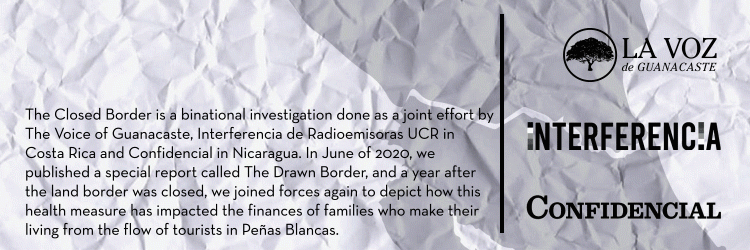


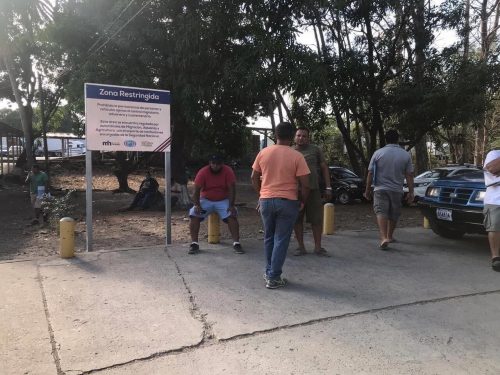
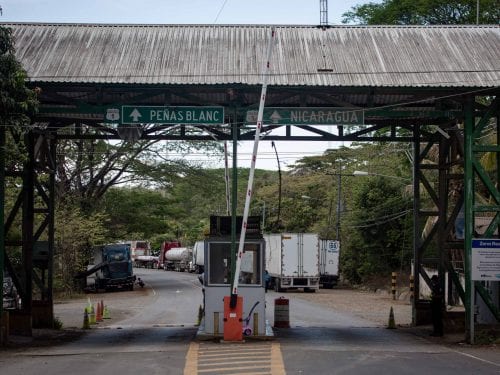
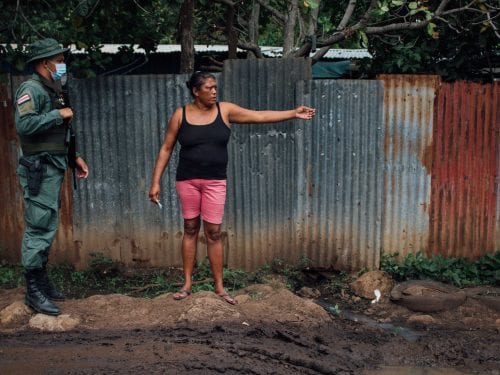

Comments